The Cooler Master MasterCase 5 Review
by E. Fylladitakis on August 27, 2015 9:00 AM EST- Posted in
- Cases/Cooling/PSUs
- Cooler Master
- mid-tower
- Case
- Freeform
Test Setup
Professional testing requires the emulation of real-world situations but with repeatable results; thus, a perfectly controllable test setup and environment are required, especially for comparable results. Testing the thermal performance of any case with a typical real-world setup technically limits the comparability of the results to this setup alone, as an active system interacts with its environment and the change of a single component would alter myriads of variables. As such, we developed synthetic loads that emulate the thermal output of real systems, which however are passive, steady and quantifiable. As such, the thermal testing now displays the thermal capabilities of the case alone, as if it would have to deal with the entire thermal load by itself, regardless of the system that would be installed inside it. Laboratory data loggers are being used to monitor the PT100 sensors and control the safety relays, which are fully accessible via our custom software. Three such loads have been developed; the ATX version simulates a 200W CPU, 50W VRM, 30W RAM and 4 × 120W GPU card thermal load. Finally, three 3.5" HDD dummy loads have also been created, with each of them converting 30 W of electrical power to thermal, bringing the total thermal load of the ATX test setup up to 850 Watts. As such, the thermal load is immense and only the best of cases will be able to handle it for more than a few minutes, we are also performing a test with a thermal load of 400W, with all of the aforementioned components except the HDD drives at about 42% power, which is more suitable for the majority of cases.
Thermal testing has been performed with all of the case's stock fan operating at maximum speed. Noise testing has been performed with a background noise level of 30.4dB(A). Advanced noise testing is also being performed, in order to assess the ability of the case to dampen the noise of the components installed inside it. This includes the installation of two noise-generating sources (strong fans) inside the case, one positioned approximately over the first expansion slot and one over the CPU area, which generate ≈ 44.2 dB(A) when unobstructed. During the advanced noise test, all stock cooling options of the case are entirely disabled.
Results and Discussion
Taking into account the size and design of the MasterCase 5, we anticipated that it would perform about as well as any good Midi-ATX tower. Its primary sales point, the modular design, is not something that could directly affect thermal performance. Still, it is a well-ventilated case and thus it is not lacking in comparison with the competition, offering similar thermal performance as other high performance designs. It falls just a little behind the Phanteks Enthoo Pro, a case that has about the same volume as the MasterCase 5. Both the Corsair 450D and the SilverStone Fortress FT05 outperform the MasterCase 5 by a few degrees, but both of these cases come with superior stock cooling solutions as well.
The two stock cooling fans of the Cooler Master MasterCase 5 are deceptively loud for their size and type. They are not ear bursting but we expected to see lower sound pressure figures than these. This is not entirely due to bad quality or overly powerful fans however. A large portion of the noise comes from the aerodynamic drag caused by the vents and case components. In other words, the air moved by the fans through the grills/vents is causing the high sound pressure levels. When the speed of the fans is halved, where the air pressure is very low, there is virtually no audible sound at all.
The lack of sound dampening capabilities enhances this problem. With so many openings and vents, the MasterCase 5 is unable to significantly dampen any noise source inside of it. Although the fan's noise tests hinted this, our second test using the dummy test source verified it. The MasterCase 5 reduced the sound pressure generated by our dummy noise source by just 1.3 dB(A), from 44.2 dB(A) to 42.9 dB(A). This is a very small and indiscernible difference for a human ear.


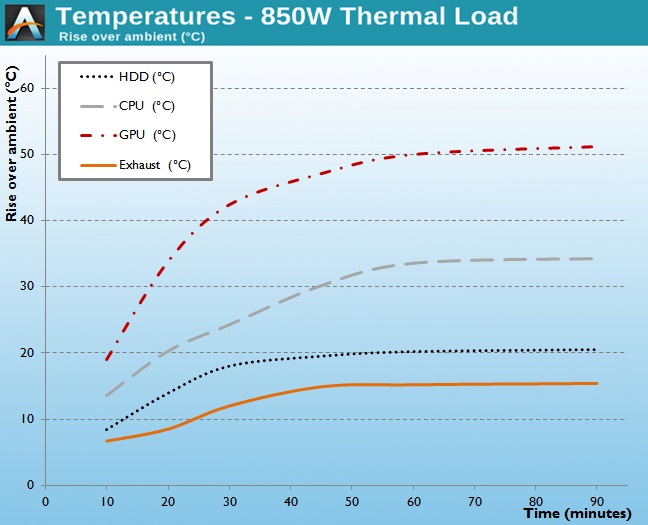
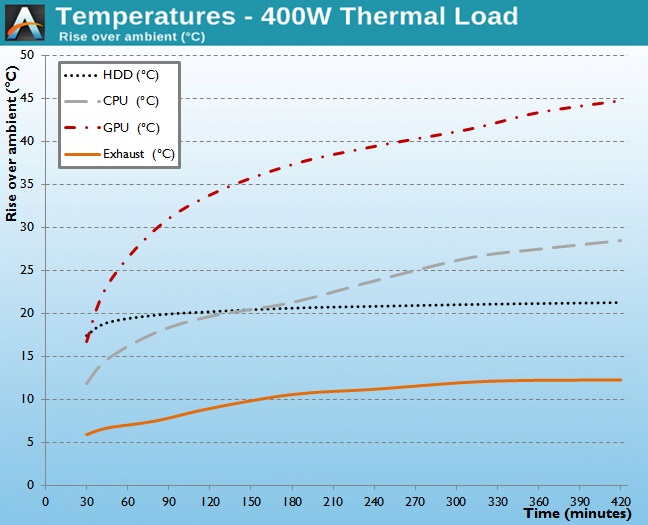
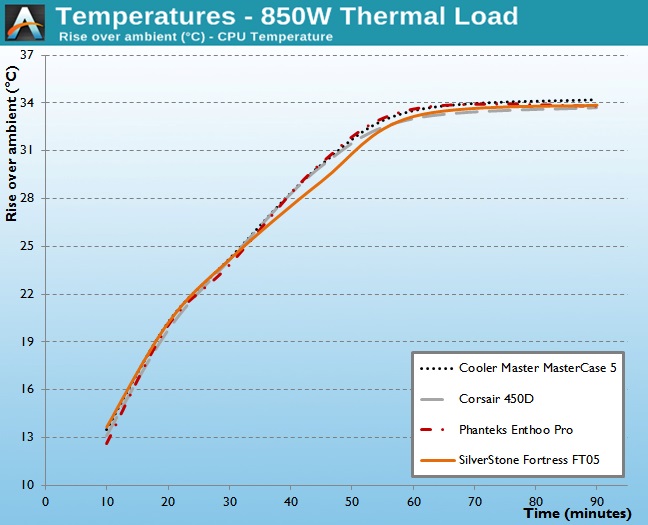
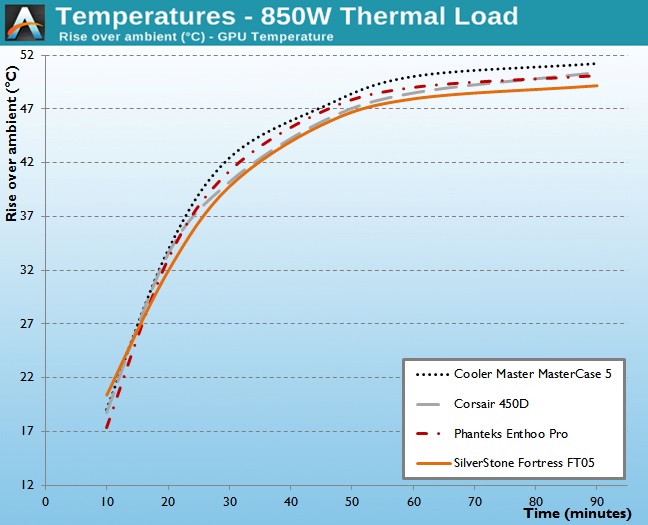
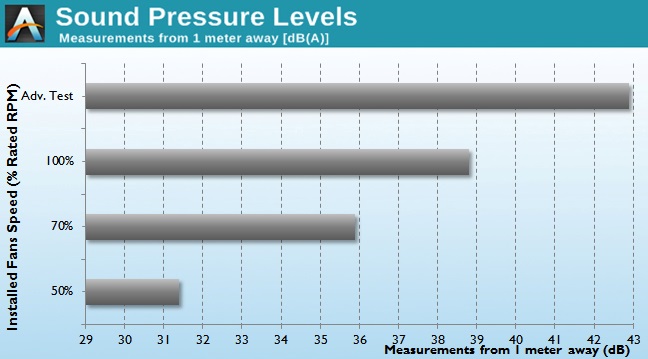








32 Comments
View All Comments
Smudgeous - Thursday, August 27, 2015 - link
Their Node 304 is fantastic. I was able to move all 6 of my 3.5" drives from my previous midtower case into that little box, plus a pair of 2.5" SSDs I wedged on the floor. Granted, you'd have to remove a pair of 3.5" drives if you wanted to throw in a PCIe card, but the fact you have that ability in something so small is fantastic in my opinion.shadvich - Thursday, August 27, 2015 - link
You don't even need to wedge the SSDs on the floor. You can attach them to the two outer 3.5" mounts (so in between the case door and the drive mount).meacupla - Thursday, August 27, 2015 - link
Node 304 is pretty large at 19.5L. It can accommodate large video cards and a 14cm double tower cooler.Node 202 (new) is a failed design. Absolutely terrible cooling performance for what it can pack.
For ITX, Silverstone, hands down.
RVZ01/FTZ01: 14L, can pack some high power parts and still remain cool.
RVZ02/ML08: 12L, slimmer version of the above, but still allows for high power parts.
SG13: 11.5L, very difficult to top this case.
romrunning - Friday, August 28, 2015 - link
Agree on Silverstone - I love my little SUGO SG05!umaxtu - Monday, August 31, 2015 - link
So using your logic, the only car anybody in the world should be buying is a Honda Accord (Which has been on Car and Driver's 10 best list 29 times). Do you want every car company in the world to only make copies of the Accord?JonnyDough - Tuesday, September 22, 2015 - link
Both are designed to meet consumer needs while increasing revenue. It's a lot like buying parts of a video game, a little at a time until your total cost is far greater than just a game.vothr - Thursday, August 27, 2015 - link
I'm not sure what to think about this computer case. I would have to build a computer with it before I could give a proper opinion.usernametaken76 - Thursday, August 27, 2015 - link
Isn't that the point of reading multiple reviews before making a purchase? Of course after purchase anyone and everyone is entitled to their opinion, but what's the point of stating the obvious?jabber - Thursday, August 27, 2015 - link
I so love dusty perspex windows. How very last decade.theduckofdeath - Saturday, September 12, 2015 - link
The custom water cooling mods are getting more popular these days, which would justify putting a windows on it. Personally I'm happy with just having a padded metal lid, like on my Silencio 352, for the silence and also not having to see the cable mess I aways leave in my PC. :D